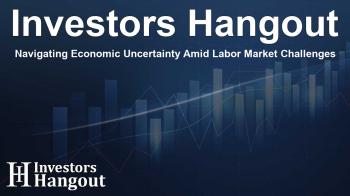Navigating Economic Uncertainty Amid Labor Market Challenges

Federal Reserve Leadership Changes and Their Implications
Recent developments have led to President Donald Trump nominating Stephen Miran, the Chairman of the Council of Economic Advisers, to fill the vacancy left by Federal Reserve Governor Adriana Kugler. Miran's nomination signals potential shifts in the Fed’s approach as he steps into the role, likely until January 31, 2026. With impending Senate confirmation expected swiftly, the upcoming Federal Open Market Committee (FOMC) meeting in September may hold significant implications for monetary policy.
Potential Dissent Among FOMC Members
As the FOMC gears up for its September vote, discussions about the best course of action regarding the federal funds rate (FFR) intensify. If the committee opts not to lower rates, it may witness at least three dissenting voices arguing for a rate cut due to the observable weakening in the labor market. Considering the arguments of dissenters highlights a critical juncture for the Fed, particularly amidst fears that a rate decrease could exacerbate inflation.
Weak Labor Market vs. Worker Shortages
The central debate currently driving economic discussions revolves around the interpretation of the latest employment report. Is the dip in employment numbers indicative of a weakening demand for labor, or is it the result of an ongoing shortage of qualified workers? It is plausible that both factors are concurrently influencing the labor market, which adds complexity for policymakers.
The Impact of Tariff Uncertainty on Hiring
One key aspect affecting employment dynamics is the ongoing uncertainty around tariffs, particularly the Tariff Turmoil that commenced in April. Many business leaders have likely postponed hiring decisions as they navigate the murky waters of how tariff changes might affect their operations and overall economic conditions. As clarity begins to emerge regarding the implications of these tariffs, hiring may resume—but this is contingent on whether employers feel secure enough to proceed.
Supply-Side Challenges in the Labor Market
However, it appears that the primary challenges within the labor market are supply-related. The growth of the labor force has stagnated this year, largely attributed to immigration policies and stricter border control measures enacted by the Trump administration. If the labor market continues to experience these supply constraints, any attempts by the Fed to cut the FFR could inadvertently boost demand for workers and worsen the existing labor shortages. Such a scenario would likely lead to heightened wage and price inflation, further complicating the economic landscape.
Future Outlook for the Federal Reserve
As the Fed considers its next moves, all eyes will be on how Miran and other members of the FOMC address the intertwined issues of labor market dynamics and inflationary pressures. Managing these challenges will be crucial for sustaining economic growth and stability. The outlook remains cautious and requires a careful balancing act from the central bank to steer through turbulent economic conditions effectively.
Frequently Asked Questions
Who is Stephen Miran and what role is he taking on?
Stephen Miran has been nominated by President Trump to serve as a Federal Reserve Governor, completing the term of Adriana Kugler.
Why is there potential dissent within the FOMC?
Some members may dissent if they believe the current labor market conditions warrant a cut in the federal funds rate to support economic growth.
What challenges is the labor market currently facing?
The labor market is dealing with both decreased demand for workers and a significant shortage of qualified labor, complicating employment trends.
How are tariffs influencing hiring decisions?
Tariff uncertainty may lead companies to hold off on hiring until they have clarity on the economic impact of these measures.
What could be the long-term effects of cutting the federal funds rate?
A rate cut could stimulate demand for workers but might also fuel inflationary pressures, posing risks to economic stability.
About The Author
Contact Dominic Sanders privately here. Or send an email with ATTN: Dominic Sanders as the subject to contact@investorshangout.com.
About Investors Hangout
Investors Hangout is a leading online stock forum for financial discussion and learning, offering a wide range of free tools and resources. It draws in traders of all levels, who exchange market knowledge, investigate trading tactics, and keep an eye on industry developments in real time. Featuring financial articles, stock message boards, quotes, charts, company profiles, and live news updates. Through cooperative learning and a wealth of informational resources, it helps users from novices creating their first portfolios to experts honing their techniques. Join Investors Hangout today: https://investorshangout.com/
The content of this article is based on factual, publicly available information and does not represent legal, financial, or investment advice. Investors Hangout does not offer financial advice, and the author is not a licensed financial advisor. Consult a qualified advisor before making any financial or investment decisions based on this article. This article should not be considered advice to purchase, sell, or hold any securities or other investments. If any of the material provided here is inaccurate, please contact us for corrections.

